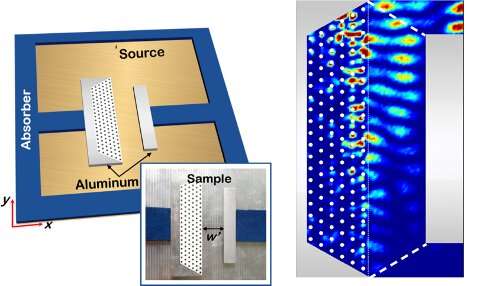The invisible gateway realized by the researchers' metamaterial superscatterer. Right: stopping coming wave into the gateway. Credit: Ye et al.
Entering an invisible doorway to catch a train at King's Cross station in London is a renowned fictional scene from the Harry Potter series. In recent decades, physicists have been trying to produce a similar effect by focusing their research efforts on illusion devices.
Illusion devices are devices that can change the optical properties of objects to match those of other virtual objects or make them apparently invisible, producing an illusion. Two common types of illusion devices are super-scatterers and invisible gateways. The first are designed to scatter light and the second to bounce back light rays through a physical gateway.
From a theoretical standpoint, super-scatterers and invisible gateways have so far been primarily studied in the context of transformation optics and folded geometry transformations (i.e., the visual, illusory transformation of objects into other objects). Experimentally realizing these devices, however, requires the use of metamaterials with specific properties (e.g., a negative permittivity and permeability) that can be difficult to employ in fabrication processes.
Researchers at Nanjing University and Xiamen University in China have recently used a metamaterial with a simultaneously negative permittivity and permeability to create one of the first big super-scatterers. In their paper, published in Physical Review Letters, they demonstrate this device's superscattering effect at microwave frequencies using field-mapping technology.
"The invisible gateway based on a perfect lens only has one circuit-based experiment," Huanyang Chen, one of the researchers who carried out the study, told Phys.org. "Our motivation was to realize a real invisible gateway for electromagnetic waves based on a previously developed theory. We were able to finish this device in the Lab of Prof. Rui-Xin Wu, ten years after we started working towards this goal."
Physicists had previously been unable to verify stopping wave propagation and other superscattering effects in illusion devices. To demonstrate the superscattering effect of the big metamaterial super-scatterer they realized, Chen and his colleagues used microwave field-mapping technology.
"This technology allowed us to directly observe the wave propagation within the super-scatterer," Prof. Wu, another researcher involved in the study, told Phys.org. "Using microwave field mapping, we observed the wave pattern for a big metal object whose size is bigger than the real size of the superscattterer and the prohibited wave propagation in a big gateway that includes a metamaterial super-scatterer."
The findings gathered by this team of researchers confirm that superscattering originates from the excitation of surface plasmons, a hypothesis introduced in previous papers. In addition, Chen, Prof. Wu and their colleagues showed that an invisible gateway could stop electromagnetic waves in an air channel with a width much wider than the cut-off width of the corresponding rectangular waveguide.
The recent paper published in Physical Review Letters provides the first direct observation of the superscattering effect in metamaterials. This observation could ultimately inspire the design of new illusion devices based on a similar design as the one realized by the researchers.
"Our paper demonstrates a real case of super-scattering, yet only for a narrow band of working frequencies," Chen said. "In addition, the doorway could be switched from a normally open state to an invisible close state by tuning the applied magnetic field. Our work is likely to inspire more research on illusion devices for microwaves. Moreover, in the future, it might also be possible to extend the concept to acoustic waves or even ocean waves."
More information: Invisible gateway by superscattering effect of metamaterials. Physical Review Letters(2021). DOI: 10.1103/PhysRevLett.126.227403.
Experimental realization of a circuit-based broadband illusion-optics analogue. Physical Review Letters(2010). DOI: 10.1103/PhysRevLett.105.233906.
A simple route to a tunable electromagnetic gateway.New Journal of Physics(2009). DOI: 10.1088/1367-2630/11/8/083012.
Journal information: Physical Review Letters , New Journal of Physics
© 2021 Science X Network
























